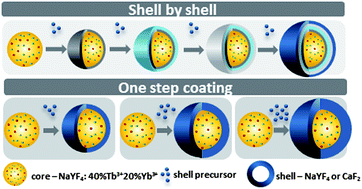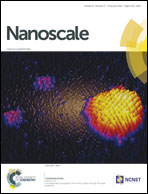The impact of shell host (NaYF4/CaF2) and shell deposition methods on the up-conversion enhancement in Tb3+, Yb3+ codoped colloidal α-NaYF4 core–shell nanoparticles†
Abstract
Lanthanide doped, up-converting nanoparticles have found considerable interest as luminescent probes in the field of bio-detection. Although the nanoparticles (NPs) have already been successfully applied for fluorescent bio-imaging and bio-assays, the efficiency of the up-conversion process seems to be the bottle-neck in rigorous applications. In this work, we have shown enhancement of the up-conversion in colloidal α-NaYF4:Yb3+, Tb3+ doped nanocrystals owing to passivation of their surface. We have studied quantitatively the influence of the shell type (NaYF4 and CaF2), its thickness, as well as the shell deposition method (i.e. single thick shell vs. multi-layer shell) on the luminescent properties of the nanoparticles. The results showed that up to 40-fold up-conversion intensity enhancement may be obtained for the core–shell nanoparticles in comparison with the bare core nanoparticles, irrespective of the shell type and deposition method. Moreover, the suitability of the NaYF4:Yb3+, Tb3+ core–shell NPs for multi-color emission and spectral multiplexing has been presented.


 Please wait while we load your content...
Please wait while we load your content...